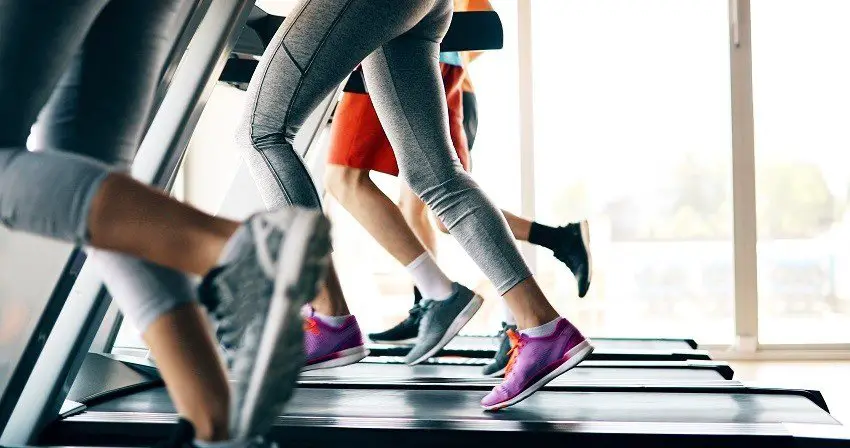Making simple, subtle changes to your running so you run more quietly can result in improving your overall technique and experience.
Running quietly is exactly what it sounds like.
You simply need to focus on making less noise each time your feet hit the ground.
Quiet running (a.k.a soft or low impact running) is gentler, more efficient and will reduce the risk of injury, it can also signicicantly reduce the amount of noise a treadmill makes when your feet strike it, making it the ideal running technique for apartment treadmill training.
Let’s take a look at how to run quietly and the benefits of doing so.
How To Run Quietly
There is no real training when it comes to quiet running.
You simply have to get out and give it a go.
On your next run focus on the sound that your feet make as they hit the ground.
Now try to make this sound quieter.
It’s as easy as that.
There are a few things that should happen when you try to run quieter:
- The impact with the ground should be softer
- Your feet should land beneath you rather than in front of you
- Your strides will be shorter
The Best Technique When Running Quietly
When you want to make changes to your running technique, it’s best to do so gradually.
A slower technique transition will help you avoid injury as it gives your body a chance to get used to the changes.
The following technique tips will help you achieve a quieter, softer run:
1. Don’t Overcomplicate It
Focus on running quietly, don’t think too much about any other adjustments as they will come naturally.
When you aim to reduce the sound of your feet hitting the ground you will automatically soften the impact and you will most likely use a different part of your foot to land (more on this when we look at the benefits later in the article).
2. Run Without Headphones
You might think you’re running quietly usually but your music can easily mask the sound of your feet pounding the pavement aggressively.

It’s best to ditch the headphones or at least listen to a calmer, quieter soundtrack as you put time into practicing low-impact running.
3. Keep Your Knees Beneath Your Hips As You Land
Your knee positioning is extremely important when you run.
Keeping your knees beneath your hips helps to ensure you maintain a proper running technique that will reduce the force of contact with each step.
Proper positioning also prevents any jolting on your knees as your feet hit the ground.
4. Use Your Core
When running, the power should be coming from your core. Using your core and hips helps to preserve your centre of gravity. It’s often thought that the calf muscles are the focus of running but this isn’t the case.
Focus on using your core and hips rather than your calf muscles.
Using your core strength improves your balance and allows the hips and lower back to work together effectively.
5. Use Short Strides
Shorter strides mean you will be taking more steps per minute.
Short strides force runners to bring their feet underneath them rather than out in front (meaning overstriding won’t be an issue).

This helps with the knee positioning mentioned earlier. A quicker cadence (stride) results in less ground contact time, less load and less pain.
6. Keep Your Shoulders & Upper Body Relaxed
Shoulder positioning can be difficult to get right when running. Don’t keep your shoulders held high and tight, they should be relaxed and low.
Be mindful of shoulder positioning throughout each run to ensure they do not begin to get high and tight.
Tight shoulders will impact a runners center of gravity.
When the shoulders are tight, try to relax them. Putting a focus on tightening your core and relaxing your hands can help too.
Also Read:
Good Form Is Essential
Whether you are quiet running or not, your form is important.
Good form makes running less tiring and more enjoyable.

Keep your posture upright so your center of gravity is aligned through your body from the crown of your head, through your shoulders and hips to your ankles.
Running quietly should feel effortless.
If you’re struggling you can try practicing when running on an incline. Uphill running requires shorter strides and gives you an opportunity to practice soft landing.
The Benefits Of Running Quietly
Running is a high impact exercise that is particularly intense on your joints, muscles and bones.
Injuries from running are common and are often the result of high stress.
This high stress comes from intense impact with the ground on each stride. Focussing on running quietly can help reduce this and so much more:
1. Improved Technique
When you run quietly your technique will be improved in several different ways.

You will adopt a more natural landing and stride which will be more efficient and will feel better for your body.
2. Softer Impact
As you are trying to run softer to reduce the sound it will also soften the impact.
A softer impact reduces the force that goes through your joints with each stride. As a result, running quieter is easier on the joints.
3. Reduced Risk of Injury
A J Sports Sci study found when running quietly most people’s running style goes from rearfoot (heel) strike to a mid or forefoot strike.
This strike change can help reduce overall loading and helps to reduce loading on the hip and knee specifically.
While this is better overall and reduces your risk of injury, a forefoot strike tends to load the calf more so it is important to keep this in mind to prevent injury.
4. More Efficient
Running softly is not faster but is more efficient.
This means the overall effort of running is decreased.
Softer running feels natural and helps you use oxygen more efficiently.
5. Strengthens Feet
Soft running helps to use small flexors in your feet that aren’t otherwise used. This helps to make the muscles in the feet more effective and helps to improve each stride.
As you can see, there are many benefits to running quietly. It is gentler on the body, reduces the chance of injury and decreases overall effort.
Stomping When Running
Stomping when you run is a sign of poor form.
You may be trying to run too fast, overstriding or taking too few strides each minute.
Learning how to run quietly is a great way to improve your form and address these issues.
Common Running Injuries
Learning how to run softly and quietly helps to reduce impact when running.
This reduces the stress you put on your body making stress-related injuries less likely.

Common running injuries are often caused by high impact and too much stress, these include:
- Runner’s knee – this is pain around the kneecap that is caused by repeated stress to the knee joint. It is usually a dull, aching pain behind or around the knee.
- Achilles tendonitis – this is inflammation of the Achilles tendon. This can cause pain and swelling in the back of the heel, tight calf muscles, and limited range of motion when flexing the foot.
- Plantar fasciitis – this is a pain in the bottom of your foot and around the heel and arch of the foot. The plantar fascia acts as a shock absorber and supports the arch of the foot when walking. Inflammation of this ligament causes pain, discomfort and irritation.
- Shin splints – shin splits is pain at the front of the shin bone. It is a cumulative stress disorder that occurs from repeated stress on the muscles, bones and joints.
- Stress fractures – these are cracks in a bone that are often caused by repetitive force/ overuse. It can be painful, tender and there may be swelling around the fractured area.
Each of these injuries is more likely to occur as a result of repeated stress or overuse of the joints, muscles and bones.
By adopting a softer running technique you are reducing the amount of stress being put on the body.
When Running Quietly Isn’t A Good Idea
Quiet running will naturally come hand in hand with slower running, so it’s best not to think about quiet running when you are in a race or trying to achieve your best time.
When you run faster you run louder and that’s just how it happens.
Ultimately, you will run more efficiently when running quietly but you won’t clock in your fastest time.
Keep Practicing
Running quietly has several benefits so it’s worth trying to bring softer running into your general running routine.
If you are a regular runner then it is best to introduce quieter running slowly.
Add short, quiet runs into your training.
Your foot strike will likely change with quieter running so it’s best not to immediately switch to always running quietly.
As an Amazon Associate I may earn a small fee from qualifying purchases at no extra cost to you. This helps us run the site, so thanks for your support!